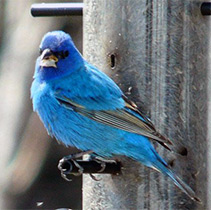
As well as birdwatching, Grand Manan also has a very interesting assemblage of land fauna and freshwater fish.
• Because of isolation, only those species who could swim across stretches of ocean or fly are common to the island (for instance, birds, bats, otters, marine mammals). As a result marine mammal diversity is much higher than native land mammals, reptiles and amphibians combined. Once the island was permanently settled, the list has changed as species (both plants and animals) have been introduced and established. With the absence of predatory animals here on the island, you’re bound to catch site of introduced deer and rabbits during your stay.
Situated on a major eastern flyway, the Grand Manan Archipelago is best known and renowned as a bird watcher's paradise, and recognized as a world-class birding area, often recognized as one of the top ten locations in North America.
• The Grand Manan Archipelago drew the attention of John James Audubon who visited in May, 1831, with the hope to find juvenile Herring Gulls and Atlantic Puffins. Young Herring Gulls were becoming increasingly rare as settlers gathered eggs from the nests and the Herring Gull population dropped. Puffins colonies were being decimated when the adults were collected and used for bait to catch fish. He was able to find specimens of both (gulls from White Head Island and puffins from Machias Seal Island) and used them as the basis for his paintings. He also collected some Common Eiders for his species paintings.
• While the number of species is not necessarily larger than any other location, a combination of land birds, shorebirds and seabirds can be easily found in one day over a relatively small area.
Over 360 species have been reliably identified, 131 of which have been found breeding here since 1900. ‘Birding’ is a year round past time for many islanders (reveling in the winter with thousands of seabirds - common murres, razorbills, kittiwakes and dovekies - just offshore or along the ferry route), but the best times for visitors are the spring migratory periods (early April to early June), followed by the summer nesting season and the fall migratory period. The latter actually begins in late July when many shorebirds and phalaropes return from nesting in high Arctic regions.
Seabirds
• Coming to Grand Manan on the ferries is a great start to finding seabirds since the ferries cross through a prime feeding area.
• Whale watches are also pelagic seabird watches on most days (pelagic seabirds are those birds who live their lives on the ocean, not coming to shore except to nest) where sometimes thousands, can be seen on these trips, since seabirds feed on the same prey as many whales. At times, there is so much activity it is difficult to know where to look. Whale watch guides are well-versed in the seabird species.
• Special tours to a nesting seabird colony (Machias Seal Island) are also available. A limited number of people are allowed on the nesting colony daily and it is truly an awe-inspiring trip being up close and personal with Atlantic Puffins, Razorbills, Common Murres and other nesting seabirds. Tours can also be arranged to Three Islands where the Bowdoin Scientific Research Station is located.
• On Grand Manan, seabirds can be seen from any prominent headland, including from the three lighthouses on Grand Manan. If you are at the wilderness campground on the northern end of the island, the seabirds may also serenade you through the night if prey is close to shore.
RESOURCES:
The publication CHECKLIST OF GRAND MANAN BIRDS, 2004 by BRIAN DALZELL, gives descriptions for birders.
Bird Checklist – Download PDF
24 Prime Birding Locations in the Grand Manan area – Download PDF
Checklist of land mammals, freshwater fish, reptiles and amphibians, dragonflies, damselflies and butterflies – Download PDF